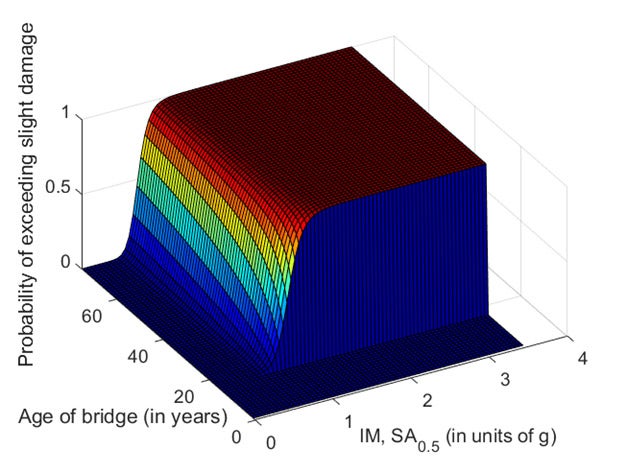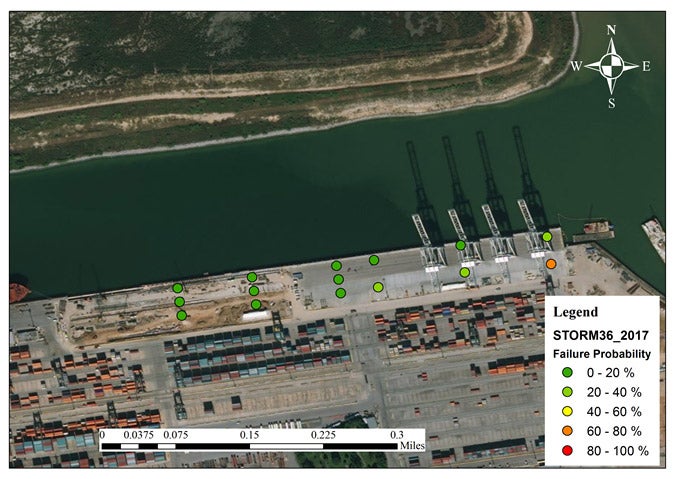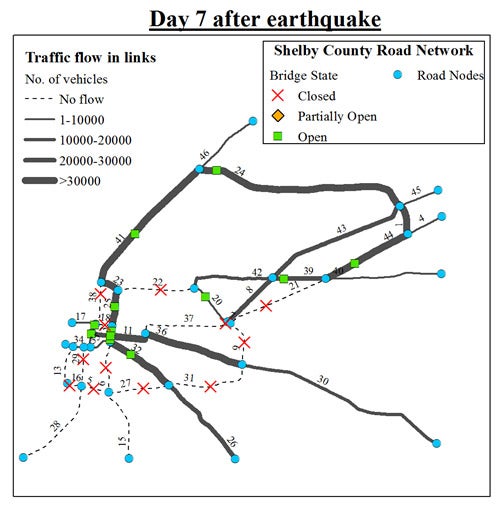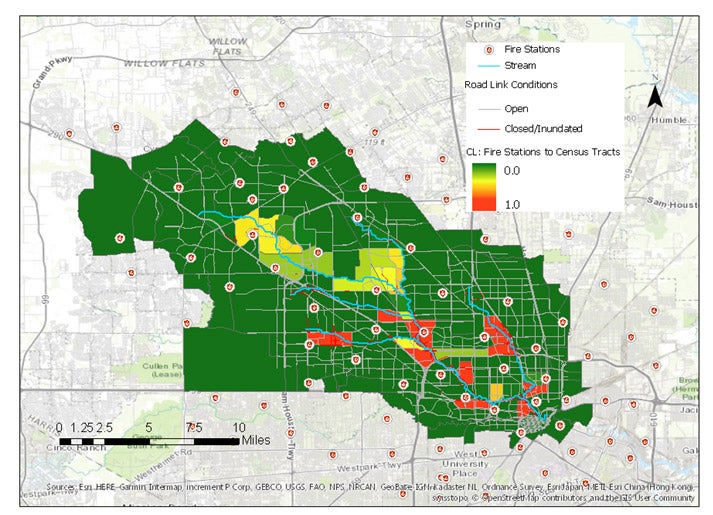Multi-Hazard Risk and Resilience of Single and Intermodal Transportation Infrastructure
A cornerstone of our research is risk and resilience modeling of transportation infrastructure from the component to system level. We have past and ongoing research projects that address infrastructure ranging from highway bridges to roadways, and rail roads to ports. The resilience of these systems are evaluated under multiple hazards such as earthquakes, hurricane induced coastal surge and waves, as well as inland flooding. Our work aims to provide rigorous damage characterization through the development of probabilistic fragility models, functionality and restoration modeling, along with evaluation of system or network level resilience metrics. Through this theme we are also exploring multi-scale and multi-layered models to assess the resilience of intermodal systems, such as highway and rail freight networks.

Figure 1. Example time-dependent bridge fragility surface
A) Multi-Hazard Fragility Modeling
Fragility models of infrastructure components constitute an essential input for risk and resilience analysis of infrastructure systems. These models typically provide the probability of structural damage (or limit state exceedance) given the hazard intensity and potentially other characteristics of the system. The Padgett Research Group has developed methods and models for assessing the fragility of such transportation structures as highway bridges, railway bridges, roadways, and port structures (e.g. pile-supported wharves and piers). We consider vulnerability under independent, concurrent, and cascading multi-hazard conditions such as earthquakes, storm surge, wind, waves and flooding. A combination of physics-based, data-driven, and statistical approaches are leveraged, often employing high fidelity numerical models and machine learning methods. Our interests are in developing methods that enable rigorous assessment of the dynamic behavior of structures when subjected to complex loading conditions, efficient uncertainty characterization and propagation, and practical application across regional portfolios of tens, hundreds, or thousands of structures that may constitute an infrastructure system.

Figure 2. Application of port fragility models in scenario-based risk assessment
B) Restoration Models
Restoration of functionality for critical transportation infrastructure such as roads, railway tracks and bridges is one key aspect of resilient transportation network. Immediate post hazard decision making on traffic closures and the consequent closure durations, as well as the temporal evolution and staging of restoration activities can have major impacts on overall network resilience. Our work seeks to build restoration models for various transportation infrastructure using combinations of methods such as expert opinion surveys, empirical data from past events, and statistical analysis. Restoration models help to map observed structural damage to roadway/railway/bridge functionality, taking into account lane/track closures, speed restrictions and load restrictions. Resulting restoration models, such as logic tree models, provide key links to understanding the time evolving condition status of infrastructure components and inform network level analysis of transportation infrastructure.

C) System and Network Resilience
In order to gain a system level understanding of the performance of interconnected infrastructure systems such as transportation networks, Padgett Research Group also focusses on evaluating metrics of network resilience following disruptions caused by earthquakes, hurricanes, and floods. Here we look at individual transportation systems as well as multi-layer networks such as rail-highway intermodal systems. The various metrics of interest for transportation networks range from accessibility to critical facilities such as hospitals, to connectivity and travel time in disrupted highway networks, to value of disrupted freight movement on rail/intermodal networks after a disruptive hazard event. The temporal evolution of these metrics and their cumulative impact is evaluated along with assessment and prioritization of interventions, including pre-event mitigation strategies and post event deployment of resources.

D) Post-Event Field Reconnaissance
Along with physics-based and statistical modeling, our research group leverages field data for validation or model building purposes. This includes efforts in post-event reconnaissance to collect data and insights regarding infrastructure performance that may contribute to the body of knowledge regarding damage modes and cascading effects of hazard damage to structures or infrastructure restoration in time. For example, the Padgett Research Group conducted a series of reconnaissance studies in the Houston and Galveston area (https://goo.gl/Z3JQ8m). A detailed report of the reconnaissance observations and findings is available via the DesignSafe Cyberinfrastructure Data Depot at https://goo.gl/5jKG1P. Such data can be used for empirical fragility model development, numerical model validation, and hindcast studies. Padgett is a Co-PI on the NSF Funded NHERI DesignSafe-CI which offers a data repository for such data, as well as cyberinfrastructure that supports the full research life-cycle including simulation and access to high performance computing, data analytics in the cloud, project collaboration space, publication and archiving.
